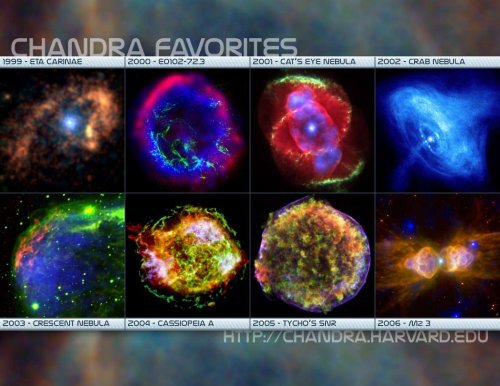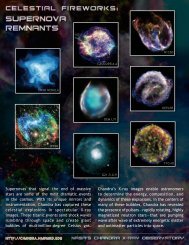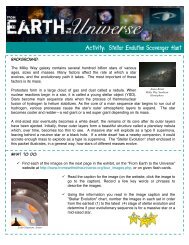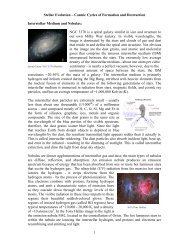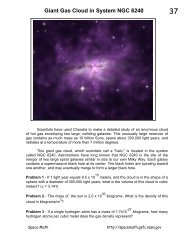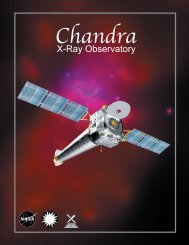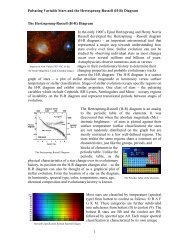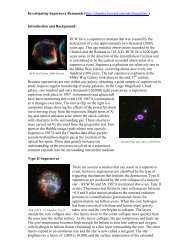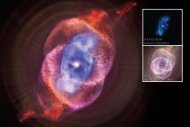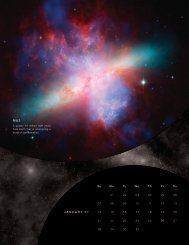Eta Carinae 2000 - E0102-72.3 2001 - Chandra X-ray Observatory
Eta Carinae 2000 - E0102-72.3 2001 - Chandra X-ray Observatory
Eta Carinae 2000 - E0102-72.3 2001 - Chandra X-ray Observatory
You also want an ePaper? Increase the reach of your titles
YUMPU automatically turns print PDFs into web optimized ePapers that Google loves.
1999 - <strong>Eta</strong> <strong>Carinae</strong> <strong>2000</strong> - <strong>E0102</strong>-<strong>72.3</strong> <strong>2001</strong> - Cat’s Eye Nebula 2002 - Crab Nebula<br />
2003 - Crescent Nebula 2004 - Cassiopeia a 2005 - Tycho’s SNR 2006 - Mz 3
<strong>Chandra</strong> Favorites * 1999 - 2006<br />
The <strong>Chandra</strong> X-<strong>ray</strong> image shows the<br />
complex nature of the region around<br />
<strong>Eta</strong> <strong>Carinae</strong>, a massive supergiant star<br />
that is 7,500 light years from Earth.<br />
The outer horseshoe shaped ring has a<br />
temperature of about 3 million degrees<br />
Celsius. It is about two light years in<br />
diameter and was probably caused by<br />
an outburst that occurred more than a<br />
thousand years ago. The blue cloud in<br />
the inner core is three light months in<br />
diameter and is much hotter; the white<br />
area inside the blue cloud is the hottest<br />
and may contain the superstar which is<br />
vigorously blowing matter off its surface.<br />
About 400,000 years ago, a massive star<br />
in the Crescent Nebula ejected its outer<br />
layers at about 20,000 miles per hour and<br />
expanded into a red giant. Two hundred<br />
thousand years later, intense radiation<br />
from the star’s exposed hot, inner layer<br />
began pushing gas away at over of 3<br />
million miles per hour! The collision of<br />
the fast stellar wind with the slower red<br />
giant wind compressed gas into a dense<br />
shell (red), and produced two shock<br />
waves: an outward-moving shock that<br />
is visible at optical wavelengths (green),<br />
and an inward-moving shock wave that<br />
created a bubble of 2-million-degree<br />
X-<strong>ray</strong> emitting gas (blue).<br />
The <strong>Chandra</strong> X-<strong>ray</strong> image (blue) shows<br />
gas that has been heated to millions of<br />
degrees Celsius by a shock wave moving<br />
into matter ejected by the supernova.<br />
This gas is rich in oxygen and neon.<br />
The radio image (red) made with the<br />
Australia Telescope Compact Ar<strong>ray</strong>,<br />
traces the outward motion of a shock<br />
wave due to the motion of extremely<br />
high-energy electrons. The optical image<br />
(green) made with the Hubble Space<br />
Telescope, shows dense clumps of<br />
oxygen gas that have “cooled” to about<br />
30,000 degree Celsius.<br />
This spectacular image of the supernova<br />
remnant Cassiopeia A is the most<br />
detailed image ever made of the remains<br />
of an exploded star. The one million<br />
second image shows a bright outer<br />
ring (green) ten light years in diameter<br />
that marks the location of a shock wave<br />
generated by the supernova explosion.<br />
A large jet-like structure that protrudes<br />
beyond the shock wave can be seen in<br />
the upper left. In this image, the colors<br />
represent different ranges of X-<strong>ray</strong>s with<br />
red, green, and blue representing, low,<br />
medium, and higher X-<strong>ray</strong> energies.<br />
<strong>Chandra</strong> X-<strong>ray</strong> <strong>Observatory</strong> data (purple)<br />
shows a bright central star surrounded by<br />
a cloud of multimillion-degree gas in the<br />
planetary nebula known as the Cat’s Eye.<br />
The central star is expected to collapse<br />
into a white dwarf in a few million years.<br />
This composite image with Hubble Space<br />
Telescope data (red and green) shows<br />
where the hot, X-<strong>ray</strong> emitting gas appears<br />
in relation to the cooler material seen in<br />
optical wavelengths. A planetary nebula<br />
(so called because it looks like a planet<br />
when viewed with a small telescope) is<br />
formed when a dying red giant star puffs<br />
off its outer layer, leaving behind a hot<br />
central core.<br />
X-<strong>ray</strong> data shows a bubble of hot<br />
supernova debris (green, red) inside a<br />
more rapidly moving shell of extremely<br />
high-energy electrons (blue). These<br />
features were created as the supersonic<br />
expansion of the debris into interstellar<br />
gas produced two shock waves - one that<br />
moves outward and accelerates particles<br />
to high energies, and another that moves<br />
backward and heats the stellar debris.<br />
The relative expansion speeds of the hot<br />
debris and the high energy shell indicate<br />
that a large fraction of the energy of the<br />
outward-moving shock wave is going<br />
into the acceleration of atomic nuclei to<br />
extremely high energies.<br />
HTTP://chandra.harvard.edu<br />
1999 - <strong>Eta</strong> <strong>Carinae</strong> <strong>2000</strong> - <strong>E0102</strong>-<strong>72.3</strong> <strong>2001</strong> - Cat’s Eye Nebula 2002 - Crab Nebula<br />
2003 - Crescent Nebula 2004 - Cassiopeia a 2005 - Tycho’s SNR 2006 - Mz 3<br />
<strong>Chandra</strong> data provide a dramatic look<br />
at the activity generated by the pulsar<br />
(white dot near the center of the images)<br />
in the Crab Nebula. The inner X-<strong>ray</strong> ring<br />
is thought to be a shock wave that marks<br />
the boundary between the surrounding<br />
nebula and the flow of matter and<br />
antimatter particles from the pulsar.<br />
Energetic shocked particles move<br />
outward to brighten the outer ring and<br />
produce an extended X-<strong>ray</strong> glow. The<br />
jets perpendicular to the ring are due to<br />
matter and antimatter particles spewing<br />
out from the poles of the pulsar.<br />
This composite image (X-<strong>ray</strong>/blue,<br />
optical/green, and infrared/red) shows a<br />
scene of the unfolding drama of the last<br />
stages of the evolution of sun-like stars.<br />
Planetary nebulas are produced in the<br />
late stages of moderate-mass stars’ life.<br />
Over a period of a few hundred thousand<br />
years, much of a star’s mass is expelled<br />
at a relatively slow speed. This mass loss<br />
creates a more or less spherical cloud<br />
around the star and eventually uncovers<br />
the star’s blazing hot core. Later, shock<br />
waves generated by the collision of<br />
high-speed gas from the hot core with<br />
the previously ejected cloud create the<br />
multimillion degree bubbles.


